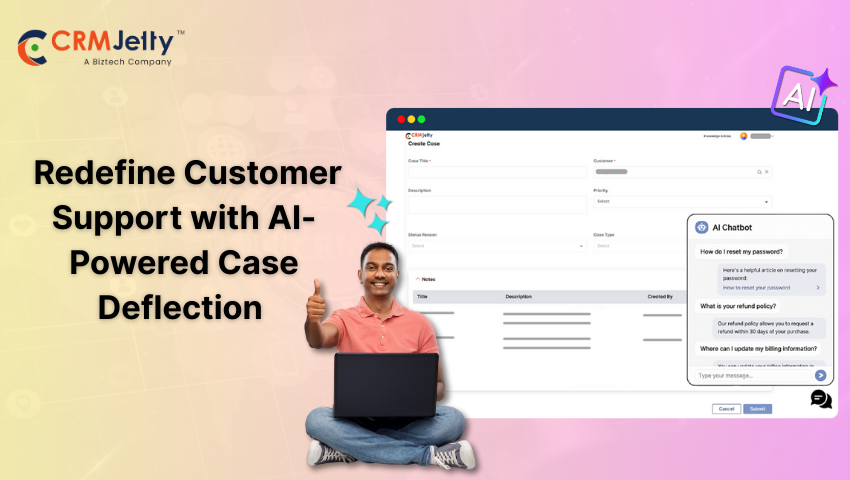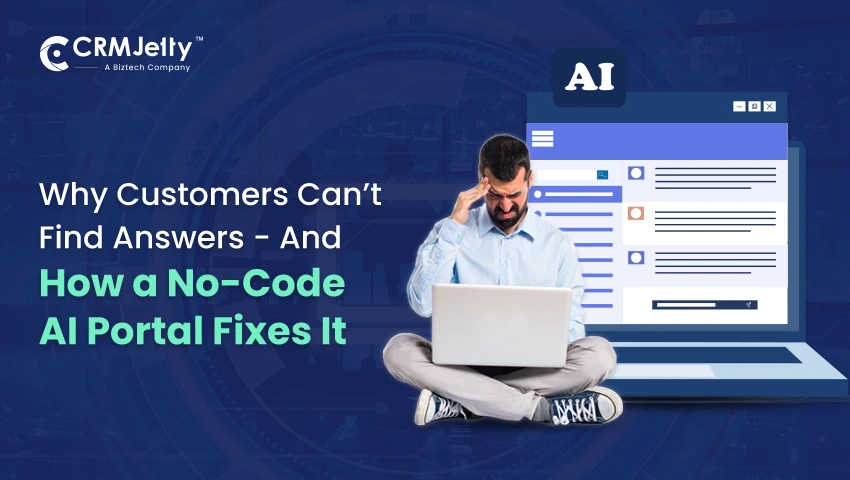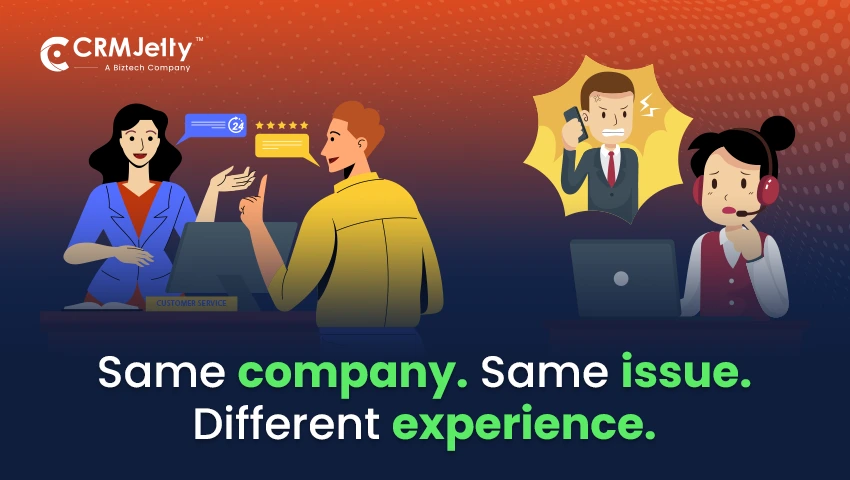Why Every Service Company Needs a Self-Service Customer Portal — Powered by CRMJetty
80% of customer service interactions are expected to be handled by AI or self‑service portals by 2025. And 90% of consumers now expect to access support through an online portal .
If your customers still need to call or email just to manage a simple appointment or view an invoice, you’re falling behind.
Today’s service brands can’t win on product or price alone. They win by offering speed, transparency, and control. When you force customers to wait or suffer through disconnected communication, you lose trust and loyalty.
Here is what is going wrong.
What’s Holding Service Companies Back?
Most service companies work hard to deliver quality, but outdated processes keep getting in the way. Customers face delays. Teams waste time on tasks that should be automated. And valuable data stays locked in disconnected tools.
Below are five common pain points that slow down service delivery, frustrate customers, and drain internal resources all of which a modern customer portal can solve.
1. “I have to call every time I want to check on a service request.”
Customers today expect the same level of convenience from service companies that they get from e-commerce or food delivery apps. They want real-time access to their information. But in many service businesses, the only way to check a service request status is to call or email the support team.
This creates a frustrating loop. Customers must wait in phone queues or refresh their inbox for a reply. Even small requests like checking if a technician is on the way turn into support tickets. These interactions waste time on both ends.
For businesses, it becomes a volume problem. The support team is overwhelmed with repetitive questions. Team productivity drops, and more important, high-priority issues are delayed. Managers lose visibility into what’s causing the delays. The customer experience suffers, and trust erodes.
2. “We spend hours every week chasing invoices and summaries.”
Billing is one of the most common sources of friction in service companies. Customers regularly ask for copies of invoices, payment receipts, or service summaries. And in most cases, these are sent manually via email.
This creates an endless cycle of document requests, follow-ups, and manual searches. Files are often buried in email threads or stored in separate systems that don’t talk to each other. A simple document request turns into a 20-minute task.
Delays in sharing invoices mean delays in payment. When customers don’t receive a clear, consistent record of the services they’re paying for, it causes confusion. That confusion can quickly turn into distrust.
This also adds to the workload of your support and accounting teams, pulling them away from value-added activities and burning out resources on avoidable tasks.
3. “Our field teams and customers are never in sync.”
For companies that rely on field service, alignment between the customer and the field team is crucial. Appointments are booked over the phone, details are confirmed over WhatsApp, and updates are shared via email. There’s no centralized record. If a customer needs to reschedule, there’s often a lag before the technician is informed. If a technician is running late, the customer may not find out until they’ve already spent 30 minutes waiting.
The impact is huge. Missed or delayed appointments result in lost revenue, rescheduling costs, and customer frustration. Field technicians waste time and fuel going to wrong addresses or empty homes. Managers struggle to identify what went wrong.
4. “Every password reset and update request floods our helpdesk.”
Support desks aren’t just handling service issues. They’re buried under a mountain of basic administrative tasks. Password resets. Profile edits. Contact information changes.
These tasks seem small, but they come in frequently and require an agent’s time. Each request interrupts the flow of support work and slows response times for more complex tickets. Agents get bogged down in routine work that adds no strategic value.
For customers, these delays are frustrating. No one wants to wait hours or days just to update an email address. But without an easy way to handle these tasks independently, they’re forced to wait.
5. “I want to upsell, but I don’t even know what services a customer has used.”
Personalization is key to growing customer relationships. But many service businesses struggle to offer tailored recommendations because they can’t see what a customer has already done.
When service history, preferences, and past interactions are locked in different tools or not recorded at all, teams operate in the dark. Sales reps can’t identify upsell opportunities. Support agents can’t reference past issues. Marketing teams can’t segment their outreach.
This lack of insight leads to one-size-fits-all communication. Customers receive irrelevant offers or repeat recommendations for services they already used. It makes the business look disconnected and inattentive.
Even worse, these data gaps make it impossible to track engagement across the customer lifecycle. You don’t know when to follow up, what message to send, or what channel to use. The result? Missed revenue and shallow customer relationships.
If any of that sounds familiar, you’re not alone. Most service companies juggle excel sheets, emails, CRMs, WhatsApp threads, and manual notes just to deliver the basics. And every time a customer needs something simple like rescheduling an appointment, they have to reach out, wait, and hope nothing gets missed.
It’s time to change the experience. It’s time to let your customers help themselves.
The Solution: CRMJetty’s Customer Portal for Service Companies
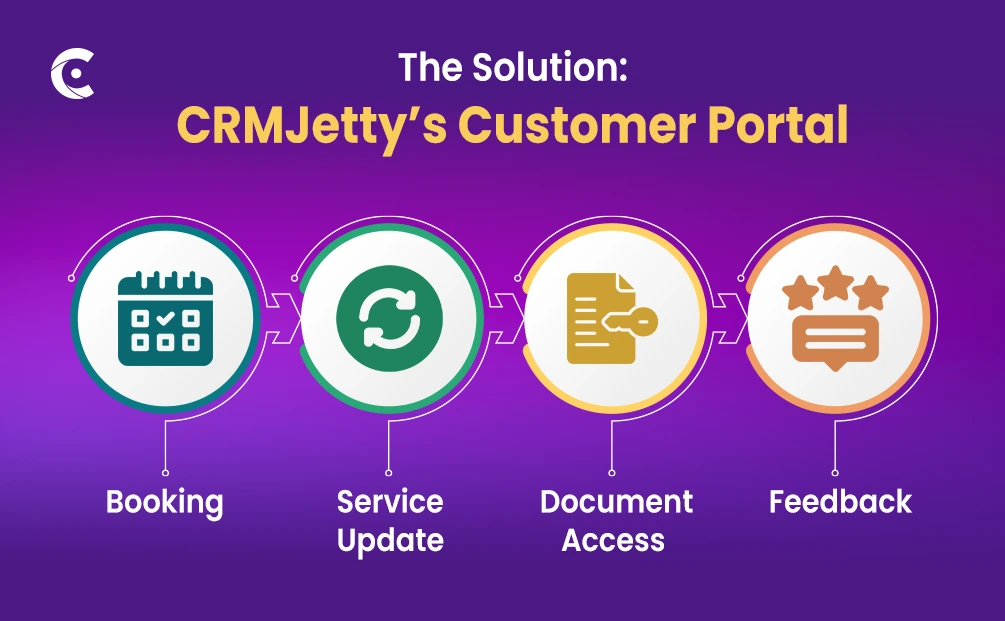
CRMJetty’s customer portal for service companies solves these challenges at the root. Built to integrate seamlessly with your CRM and service workflows, the portal gives your customers direct access to everything they need while reducing the burden on your team.
This isn’t another support tool. It’s a centralized, self-service experience designed to handle bookings, updates, support, and communication.
Self-Managed Appointments, Without the Hassle
Service companies often lose hours each week to manual scheduling. Customers call to book. They call again to reschedule. Teams coordinate over phone, email, or messaging apps. Every change creates a new loop.
CRMJetty’s appointment scheduling portal changes that. Customers can schedule, cancel, or reschedule appointments on their own anytime, from any device. Whether it’s a home repair, IT consultation, legal service, or equipment maintenance, the experience is the same: fast and friction-free.
Because the portal connects directly with your CRM, appointment data stays updated across your systems. No one has to enter details twice. No one has to confirm over email. The calendar updates in real time, and both your internal team and the customer stay aligned.
Centralized Document Access and Service History
Support shouldn’t have to dig through emails or offline folders to find a document. But in most companies, that’s exactly what happens when a customer asks for an invoice, service summary, or contract copy.
CRMJetty’s CRM customer portal gives customers one place to view everything. Service history. Past invoices. Uploaded files. All documents are connected to the customer’s profile and synced with your CRM.
For your team, this means fewer document requests. For your customers, it means instant access without back-and-forth. Everyone saves time.
AI-Powered Self-Service & Smart Forms
Not every customer query needs a human agent. In fact, most don’t. Questions like “How do I cancel an appointment?” or “Where can I download my receipt?” should have instant answers.
With CRMJetty’s AI assistant, customers get them. Built-in natural language search helps users navigate your knowledge base. Smart prompts walk them through tasks. And when support is needed, AI-powered forms collect details quickly and accurately, reducing ticket volume and improving resolution quality.
Secure, Role-Based Access for Every Customer
Whether you serve individuals, teams, or enterprises, data access matters. Every customer should only see what they’re allowed to see.
CRMJetty’s portal uses role-based access control to manage visibility and permissions. A residential customer may see just their bookings and payments. A B2B client may access service reports for multiple locations.
No-Code Setup, Full Flexibility
Traditional customer portals often need developer support for every change.
But not with the CRMJetty portal!
It is a no-code builder by design. Your business team can configure layouts, add branding, launch new modules, or update features, all without any technical person’s help.
This flexibility helps you move faster. Want to add a review form? Enable live chat? Introduce multilingual support? Do it with clicks, not code.
CRMJetty vs. Disconnected Tools
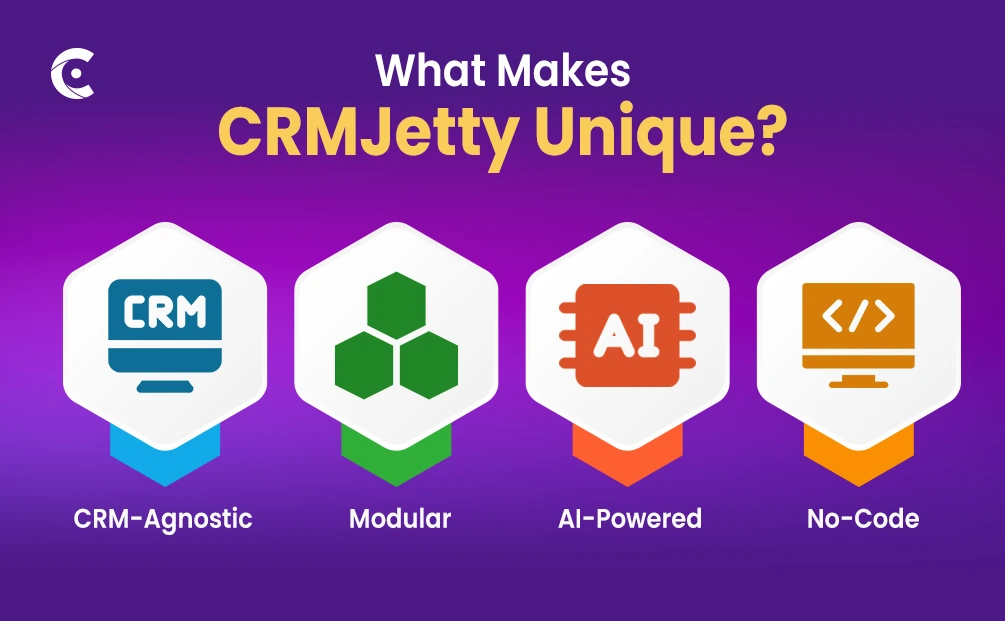
Switching to a self-service portal isn’t just about improving customer experience. It’s a strategic move that directly impacts your team’s productivity, service delivery, and long-term profitability.
Let’s break down the difference CRMJetty’s portal makes compared to disconnected tools and siloed systems.
| Before CRMJetty | After CRMJetty |
|---|---|
| 40–60% of agent time spent on routine queries like password resets, appointment changes, or document requests. | Up to 70% fewer inbound queries through self-service tools, AI forms, and knowledgebase access. |
| Appointments handled via phone or email with manual confirmation and follow-ups. | Centralized appointment scheduling portal integrated with CRM and synced in real time. |
| Invoices, summaries, and contracts shared manually through email or messaging apps. | Customers access and download documents directly through the portal, reducing back-and-forth. |
| Customer communication scattered across phone calls, WhatsApp, emails, and spreadsheets. | No more disconnected customer communication. All service updates and interactions happen in one place. |
| Data spread across multiple tools that don’t talk to each other. Teams operate in silos. | CRM data silos are eliminated. Customer interactions, preferences, and history are unified in one portal. |
| Missed upselling and cross-selling opportunities due to lack of service history visibility. | Teams get a full customer view with AI-powered insights to personalize recommendations and increase revenue. |
Industries That Benefit
Here’s how different industries feel the impact of disconnected customer communication and CRM data silos and why a customer portal for service companies isn’t just helpful, but essential.
1. Nonprofits
Problem: Donor engagement is heavily dependent on manual processes. Donors email or call for donation receipts, event updates, or volunteer schedules.
Result: Administrative staff spends hours tracking down documents or confirming event registrations. Communication gaps hurt donor trust and delay campaign efforts.
2. Education
Problem: Students and parents need constant access to schedules, exam results, and fee receipts. But most information is locked in systems that aren’t connected or worse, shared manually through emails.
Result: School and university staff waste valuable hours answering repetitive questions. Parents are forced to call for even basic updates. Students miss deadlines because information is scattered.
3. Insurance
Problem: Policyholders want to track claims, update policy info, or download documents. Instead, they call agents or email support, only to wait for a response.
Result: Teams deal with a flood of low-priority requests. Customers get frustrated over delays. Meanwhile, agents lack a full view of each customer’s history, making personalized upsells nearly impossible.
4. Healthcare
Problem: Patients require access to appointments, lab results, payment receipts, and past medical records. But healthcare teams are often managing this across spreadsheets, legacy systems, and offline forms.
Result: Patients experience delays, double bookings, or incomplete information. Staff scrambles to share updates, often across unsecured channels. The risk of errors and dissatisfaction increases with every manual handoff.
5. Manufacturing
Problem: B2B customers and vendors expect real-time updates on order status, invoices, and delivery schedules. But manufacturers often rely on internal ERP systems with no customer-facing interface.
Result: Support teams spend time copying data into emails or fielding repeated requests. Clients get frustrated waiting for order confirmations or logistics updates.
6. Real Estate
Problem: Prospects want to explore properties, book visits, or download contracts. Agents coordinate everything manually over phone, email, or messaging apps.
Result: Sales teams spend too much time chasing follow-ups or re-sharing documents. Prospects drop off due to slow response times. Deals are lost due to miscommunication or missed meetings.
7. IT Services
Problem: Clients expect quick support, clear updates, and transparency on what’s been done. But support tickets, documentation, and status updates live in separate systems.
Result: IT teams are overwhelmed with password resets, basic requests, or follow-ups. Clients feel ignored when updates are delayed. Without a CRM-integrated service booking portal, even small issues become time sinks.
No matter your industry, if your business involves scheduling, service delivery, and ongoing customer support, a CRM customer portal is a necessity.
Stop Being the Bottleneck
Customers don’t want to wait.
They don’t want to email you for a receipt.
They don’t want to call to reschedule an appointment.
They don’t want to explain the same issue twice to different support agents.
And your team doesn’t want to waste hours on tasks that software can handle in seconds.
CRMJetty’s customer portal for service companies removes the bottlenecks from both sides. It cuts the delays, the back-and-forth, and the confusion that slows service down.
You give your customers what they expect: control, transparency, and access. You give your team what they need: time, clarity, and focus.
The next time someone calls just to ask, “Can I move my appointment?” — send them to the portal. And save your team fifteen minutes.
All product and company names are trademarks™, registered® or copyright© trademarks of their respective holders. Use of them does not imply any affiliation with or endorsement by them.




